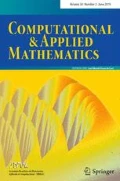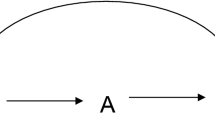Abstract
In the field of sensitivity analysis, Sobol’ indices are widely used to assess the importance of the inputs of a model to its output. Among the methods that estimate these indices, the replication procedure is noteworthy for its efficient cost. A practical problem is how many model evaluations must be performed to guarantee a sufficient precision on the Sobol’ estimates. The present paper tackles this issue by rendering the replication procedure iterative. The idea is to enable the addition of new model evaluations to progressively increase the accuracy of the estimates. These evaluations are done at points located in under-explored regions of the experimental designs, but preserving their characteristics. The key feature of this approach is the construction of nested space-filling designs. For the estimation of first-order indices, a nested Latin hypercube design is used. For the estimation of closed second-order indices, two constructions of a nested orthogonal array design are proposed. Regularity and uniformity properties of the nested designs are studied.











Similar content being viewed by others
References
Bratley P, Niederreiter BL (1992) Implementation and tests of low-discrepancy sequences. ACM Trans Model Comput Simul 2(3):195–213. https://doi.org/10.1145/146382.146385
Devroye L (1986) Non-uniform random variate generation. Springer, New York
Dey A (2012) On the construction of nested orthogonal arrays. Australas J Combin 54:37–48
Franco J, Vasseur O, Corre N, Sergent M (2009) Minimum spanning tree: a new approach to assess the quality of the design of computer experiments. Chemom Intell Lab Syst 97(2):164–169. https://doi.org/10.1016/j.chemolab.2009.03.011
Gilquin L, Rugama LAJ, Arnaud E, Hickernell FJ, Monod H, Prieur C (2017) Iterative construction of replicated designs based on Sobol’ sequences. C R Math 355(1):10–14
Hedayat AS, Sloane NJA, Stufken J (1999) Orthogonal arrays: theory and applications, Springer series in statistic. Springer, New York
Hoeffding W (1948) A class of statistics with asymptotically normal distributions. Ann Math Stat 19(3):293–325
Homma T, Saltelli A (1996) Importance measures in global sensitivity analysis of nonlinear models. Reliab Eng Syst Saf 52:1–17
Janon A, Klein T, Lagnoux A, Nodet M, Prieur C (2014) Asymptotic normality and efficiency of two Sobol’ index estimators. ESAIM Probab Stat 18:342–364. https://doi.org/10.1051/ps/2013040
Jonshon ME, Moore LM, Ylvisaker D (1990) Minmax and maxi-min distance designs. J Stat Plan Inference 26(2):131s–148. https://doi.org/10.1016/0378-3758(90)90122-B
Mara TA, Joseph OR (2008) Comparison of some efficient met-hods to evaluate the main effect of computer model factors. J Stat Comput Simul 78(2):167–178. https://doi.org/10.1080/10629360600964454
McKay MD, Conover WJ, Beckman RJ (1979) A comparison of three methods for selecting values of input variables in the analysis of output from a computer code. Technometrics 21:239–245. https://doi.org/10.2307/1271432
Monod H, Naud C, Makowski D (2006) Uncertainty and sensitivity analysis for crop models. Working with dynamic crop models. Elsevier, New York, pp 55–100
Morokoff WJ, Caflisch RE (1994) Quasi-random sequences and their discrepancies. SIAM J Sci Comput 15(16):1251–1279
Prieur C, Tarantola S (2017) Variance-based sensitivity analysis: theory and estimation algorithms. Handbook of uncertainty quantification, pp 1217–1239
Qian PZG (2009) Nested Latin hypercube designs. Biometrika 96(4):957–970. https://doi.org/10.1093/biomet/asp045
Qian PZG, Ai M, Wu CFJ (2009a) Construction of nested space-filling designs. Ann Stat 37(6A):3616–3643. https://doi.org/10.1214/09-AOS690
Qian PZG, Tang B, Wu CFJ (2009b) Nested space-filling designs for computer experiments with two levels of accuracy. Stat Sin 19:287–300
Rennen G, Husslage B, Van Dam ER, Den Hertog D (2010) Nested maximin latin hypercube designs. Struct Multidiscip Optim 41(3):371–395
Sallaberry CJ, Helton JC, Hora SC (2008) Extension of latin hypercube samples with correlated variables. Reliab Eng Syst Saf 93(7):1047–1059
Saltelli A (2002) Making best use of models evaluations to compute sensitivity indices. Comput Phys Commun 145(2):280–297
Saltelli A, Chan K, Scott EM (2008) Sensitivity analysis. Wiley, New York
Sarrazin F, Pianosi F, Wagener T (2016) Global sensitivity analysis of environmental models: convergence and validation. Environ Modell Softw 79:135–152
Sheikholeslami R, Razavi S, Gupta HV, Becker W, Haghnegahdar A (2019) Global sensitivity analysis for high-dimensional problems: how to objectively group factors and measure robustness and convergence while reducing computational cost. Environ Model Softw 111:282–299
Sobol’ IM (1993) Sensitivity indices for nonlinear mathematical models. Math Model Comput Exp 1:407–414
Stinson DR, Massey JL (1995) An infinite class of counterexamples to a conjecture concerning nonlinear resilient functions. J Cryptol 8:67–173. https://doi.org/10.1007/BF00202271
Terraz T, Ribes A, Fournier Y, Iooss B, Raffin B (2017) Melissa: large scale in transit sensitivity analysis avoiding intermediate files. In: Proceedings of the international conference for high performance computing, networking, storage and analysis, pp 1–14
Tissot JY, Prieur C (2015) A randomized orthogonal array-based procedure for the estimation of first- and second-order Sobol’ indices. J Stat Comput Simul 85:1358–1381. https://doi.org/10.1080/00949655.2014.971799
Vorechovsky M, Novak D, Rusina R (2013) Sample size extension in stratified sampling: Theory and software implementation. In: Safety, reliability, risk and life-cycle performance of structures and infrastructures: proceedings of the 11th international conference on structural safety and reliability (ICOSSAR 2013), IASSAR. CRC Press, New York
Author information
Authors and Affiliations
Corresponding author
Additional information
Communicated by Eduardo Souza de Cursi.
Publisher's Note
Springer Nature remains neutral with regard to jurisdictional claims in published maps and institutional affiliations.
Rights and permissions
About this article
Cite this article
Gilquin, L., Prieur, C., Arnaud, E. et al. Iterative estimation of Sobol’ indices based on replicated designs. Comp. Appl. Math. 40, 18 (2021). https://doi.org/10.1007/s40314-020-01402-5
Received:
Revised:
Accepted:
Published:
DOI: https://doi.org/10.1007/s40314-020-01402-5




